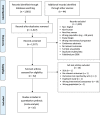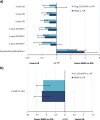Microwave ablation compared with hepatic resection for the treatment of hepatocellular carcinoma and liver metastases: a systematic review and meta-analysis
- PMID: 31182102
- PMCID: PMC6558848
- DOI: 10.1186/s12957-019-1632-6
Microwave ablation compared with hepatic resection for the treatment of hepatocellular carcinoma and liver metastases: a systematic review and meta-analysis
Abstract
Background: Hepatic resection (HR) is the gold standard liver cancer treatment, but few patients are eligible due to comorbidities or tumor location. Microwave ablation (MWA) is an important complementary liver cancer treatment to HR. This systematic review compared MWA with HR for liver cancer treatment.
Methods: A systematic search of MEDLINE, EMBASE, and CENTRAL was conducted for randomized and observational studies published from 2006 onwards. The primary outcome was local tumor recurrence (LTR), and a random effects model was used for meta-analyses.
Results: Of the 1845 studies identified, 1 randomized and 15 observational studies met the inclusion criteria. LTR was significantly increased with MWA versus HR (risk ratio (RR) = 2.49; P = 0.016). In secondary measures, HR provided significantly higher 3- and 5-year overall survival (RR = 0.94; P = 0.03 and RR = 0.88; P = 0.01, respectively) and 3-year disease-free survival (RR = 0.78; P = 0.009). MWA exhibited significantly shorter length of stay (weighted mean difference (WMD) = - 6.16 days; P < 0.001) and operative time (WMD = - 58.69 min; P < 0.001), less intraoperative blood loss (WMD = - 189.09 mL; P = 0.006), and fewer complications than HR (RR = 0.31; P < 0.001). When MWA was combined with HR and compared with either modality alone, complications and blood loss were significantly lower with the combination treatment; however, there were no differences in other outcomes. Subgroup and sensitivity analyses were generally aligned with the main results.
Conclusions: MWA can be an effective and safe alternative to HR in patients/tumors that are not amenable to resection. More randomized and economic studies should be performed that compare the two treatments, especially to determine the target population that benefits most from MWA.
Keywords: Hepatic resection; Hepatocellular carcinoma; Meta-analysis; Microwave ablation.
Conflict of interest statement
MBG, JWC, SG, and JFA are employees of Ethicon, Inc., manufacturer of the NeuWave microwave ablation system. GWJW and NCF are employees of Cornerstone Research Group, who were sponsored to perform this study by Ethicon, Inc.
Figures







Similar articles
-
The efficacy of microwave ablation versus liver resection in the treatment of hepatocellular carcinoma and liver metastases: A systematic review and meta-analysis.Int J Surg. 2020 May;77:85-93. doi: 10.1016/j.ijsu.2020.03.006. Epub 2020 Mar 12. Int J Surg. 2020. PMID: 32173611
-
Ultrasound-guided percutaneous microwave ablation treatment of initial recurrent hepatocellular carcinoma after hepatic resection: long-term outcomes.Ultrasound Med Biol. 2015 Sep;41(9):2391-9. doi: 10.1016/j.ultrasmedbio.2015.04.019. Epub 2015 Jun 12. Ultrasound Med Biol. 2015. PMID: 26074453
-
[Comparison of the effectiveness of percutaneous microwave ablation versus hepatectomy for hepatocellular carcinoma].Zhonghua Zhong Liu Za Zhi. 2015 Apr;37(4):301-7. Zhonghua Zhong Liu Za Zhi. 2015. PMID: 26462897 Chinese.
-
Microwave ablation versus other interventions for hepatocellular carcinoma: A systematic review and meta-analysis.J Cancer Res Ther. 2020;16(2):379-386. doi: 10.4103/jcrt.JCRT_403_19. J Cancer Res Ther. 2020. PMID: 32474527
-
Ultrasound-guided percutaneous microwave ablation vs. surgical resection for thoracoabdominal wall implants from hepatocellular carcinoma: intermediate-term results.Int J Hyperthermia. 2018 Nov;34(7):1067-1076. doi: 10.1080/02656736.2017.1402131. Epub 2017 Nov 21. Int J Hyperthermia. 2018. PMID: 29161924
Cited by
-
Colorectal Liver Metastases: A Literature Review of Viable Surgical Options with a Special Focus on Microwave Liver Thermal Ablation and Mini-Invasive Approach.J Pers Med. 2022 Dec 23;13(1):33. doi: 10.3390/jpm13010033. J Pers Med. 2022. PMID: 36675694 Free PMC article. Review.
-
Image-Guided Percutaneous Ablation for Primary and Metastatic Tumors.Diagnostics (Basel). 2022 May 24;12(6):1300. doi: 10.3390/diagnostics12061300. Diagnostics (Basel). 2022. PMID: 35741109 Free PMC article. Review.
-
Effect of Severity of Liver Cirrhosis on Surgical Outcomes of Hepatocellular Carcinoma After Liver Resection and Microwave Coagulation.Front Oncol. 2021 Oct 6;11:745615. doi: 10.3389/fonc.2021.745615. eCollection 2021. Front Oncol. 2021. PMID: 34692526 Free PMC article.
-
An Analysis of Microwave Ablation Parameters for Treatment of Liver Tumors from the 3D-IRCADb-01 Database.Biomedicines. 2022 Jul 1;10(7):1569. doi: 10.3390/biomedicines10071569. Biomedicines. 2022. PMID: 35884874 Free PMC article.
-
On Efficacy of Microwave Ablation in the Thermal Treatment of an Early-Stage Hepatocellular Carcinoma.Cancers (Basel). 2021 Nov 18;13(22):5784. doi: 10.3390/cancers13225784. Cancers (Basel). 2021. PMID: 34830937 Free PMC article.
References
-
- American Cancer Society. Cancer Facts & Figures 2018 [Available from: https://www.cancer.org/research/cancer-facts-statistics/all-cancer-facts....
-
- Xu J. Trends in liver cancer mortality among adults aged 25 and over in the United States, 2000–2016. 2018. - PubMed
Publication types
MeSH terms
LinkOut - more resources
Full Text Sources
Medical
Molecular Biology Databases
Miscellaneous

